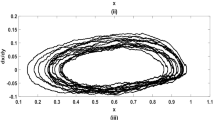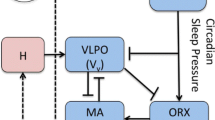Abstract
Sleep/wake cycles were once dictated by the solar day, but now humans are subjected to prolonged exposure to artificial light, resulting in altered daily sleep patterns. We investigate a van der Pol-type mathematical model for a circadian model, which incorporates a daylight and noise model, to capture the consequences of artificial light, which has become part of our daily lives. The results show that when the cycle is interpreted as a model for the sleep/awake alternation, the duration and sleep offset are influenced by light intensity, daylight duration and noise intensity. Increasing light intensity and duration can lead to a decrease in sleep duration beyond \(\sim 30\) mins. Thus, the cycle of the circadian oscillations can be influenced by a sudden change in longitude (jet lag) is much more influenced by the daily duration of light than by its intensity. Noise could cause a loss of sleep of more than 10%; in other words, artificial light could cause a decrease of more than 40 min in sleep time, which could cause a malfunction of the human mechanism. Furthermore, simulations show that the duration of sleep during the different seasons of the year reveals that it is in winter that sleep is longer in contrast to summer where the daily loss of sleep could be as much as 5% (\(\sim 20\) mins); nevertheless, the increase in noise intensity can decrease the duration of sleep in winter and make it shorter than in summer. The evolution of light over the year is slow enough for the oscillator to regulate sleep time, whereas a sudden change in latitude and the consequent change in daily light could cause major dysfunctions on sleep time and requires an adaptation time to be regulated; Indeed the adaptation to this change could take several cycles and depends on the environmental conditions, as it would be more difficult for the organism to regulate its sleep if moving from a point with long daylight to a position with shorter daylight than for a trip in the opposite direction. In brief, the mathematical van der Pol pacemaker model of the circadian rhythm driven by periodic and random terms, that mimic realistic illumination, provides quantitative information on alterations in the circadian sleep/wake pattern, in agreement with empirical observations.













Similar content being viewed by others
Data availability
The data from simulations that support the findings of this study are available on request from the corresponding author, F. L. Tsafack Tayong.
References
Touitou, Y., Reinberg, A., Touitou, D.: Association between light at night, melatonin secretion, sleep deprivation, and the internal clock: health impacts and mechanisms of circadian disruption. Life Sci. 173, 94–206 (2017)
Koo, Y.S., Song, J., Joo, E.-Y., Lee, H., Lee, E., Lee, S., Jung, K.: Cross-sectional analysis in the KoGES study: outdoor artificial light at night, obesity, and sleep health. Chronobiol. Int 33, 1–14 (2016)
Pilz, L.K., Levandovski, R., Oliveira, M.A.B., Hidalgo, M.P., Roenneberg, T.: Sleep and light exposure across different levels of urbanisation in Brazilian communities. Sci. Rep. 8
Smit, A.N., Broesch, T., Siegel, J.M., Mistlberger, R.E.: Sleep timing and duration in indigenous villages with and without electric lighting on Tanna Island, Vanuatu. Sci. Rep. 9
de la Iglesia, H.O., Fernández-Duque, E., Golombek, D.A., Lanza, N., Duffy, J.F., Czeisler, C.A., Valeggia, C.R.: Access to electric light is associated with shorter sleep duration in a traditionally hunter-gatherer community. J. Biol. Rhythms 30, 342–350 (2015)
Achermann, P., Borbely, A.: Mathematical models of sleep regulation. Front. Biosci. 8, 683–93 (2003)
Achermann, P., Dijk, D.J., Brunner, D., Borbely, A.: A model of human sleep homeostasis based on EEG slow-wave activity: quantitative comparison of data and simulations. Brain Res. Bull. 31, 97–113 (1993)
Folkard, S., Akerstedt, T.: A three-process model of the regulation of alertness-sleepiness, sleep, arousal and performance. Sleep Arousal Perform. (1992)
Kronauer, R.E., Czeisler, C.A., Pilato, S.F., Moore-Ede, M.C., Weitzman, E.D.: Mathematical model of the human circadian system with two interacting oscillators. Am. J. Physiol. 242, 3–17 (1982)
Kronauer, R.E., Forger, D.B., Jewett, M.E.: A simpler model of the human circadian pacemaker. J. Biol. Rhythms 14, 532–537 (1999)
Kronauer, R.E.: A quantitative model for the effects of light on the amplitude and phase of the deep circadian pacemaker, based on human data. In: Sleep J. A. Horne (1990)
Jewett, M.E., Forger, D.B., Kronauer, R.E.: Revised limit cycle oscillator model of human circadian pacemaker. J. Biol. Rhythms 14, 493–499 (1999)
Brown, E.N., Choe, Y., Luithardt, H., Czeisler, C.A.: A statistical model of the human core-temperature circadian rhythm. Am. J. Physiol. Endocrinol. Metab. 279, 669–683 (2000)
Diekman, C.O., Bose, A.: Reentrainment of the circadian pacemaker during jet lag: east–west asymmetry and the effects of north-south travel. J. Theor. Biol. 43, 261–285 (2017)
Rempe, M.J., Best, J., Terman, D.: A mathematical model of the sleep/wake cycle. J. Math. Biol. 60, 615–644 (2009)
Skeldon, A.C., Phillips, A.J.K., Dijk, D.: The effects of self-selected lightdark cycles and social constraints on human sleep and circadian timing: a modeling approach. Sci. Rep. 7, 45158 (2017)
Phillips, A.J.K., Chen, P.Y., Robinson, P.A.: Probing the mechanisms of chronotype using quantitative modeling. J. Biol. Rhythms 25, 217–227 (2010)
Kronauer, R.E., Forger, D., Jewett, M.E.: Quantifying human circadian pacemaker response to brief, extended, and repeated light stimuli over the phototopic range. J. Biol. Rhythms 14, 500–515 (1999)
Jewett, M.E., Kronauer, R.E.: Refinement of a limit cycle oscillator model of the effects of light on the human circadian pacemaker. J. Theor. Biol. 192, 455–465 (1998)
Tsafack Tayong, F.L., Yamapi, R., Filatrella, G.: Entrainment of van der Pol-type cicardian pacemaker to daylight cycle. Braz. J. Phys. 51, 1416–1427 (2022). https://doi.org/10.1007/s13538-021-00948-x
Tsafack Tayong, F.L., Yamapi, R., Filatrella, G.: Coherence and stochastic resonances in a noisy van der Pol-type circadian pacemaker model driven by light. Braz. J. Phys. (2022)
Gitterman, M.: Additive white Gaussian noise. In: The First Hundred Years, From Einstein Until Now, Radio Receiver Design. The Noisy Oscillator (2005)
St Hilaire, M.A., Ámundadóttir, M.L., Rahman, S.A., Rajaratnam, S.M.W., Rügera, C., Brainard , G.C., Czeisler, C.A., Andersen, M., Gooley, J.J., Lockley, S.W: The spectral sensitivity of human circadian phase resetting and melatonin suppression to light changes dynamically with light duration. PNAS 119, e2205301119 (2022)
Yonkeu, R.M., Yamapi, R., Filatrella, G., Tchawoua, C.: Effects of a periodic drive and correlated noise on birhythmic van der Pol systems. Physica A 466, 552–569 (2017)
Yamapi, R., Yonkeu, R.M., Filatrella, G., Tchawoua, C.: Effects of noise correlation on the coherence of a forced van der Pol type birhythmic system. Commun. Nonlinear Sci. Numer. Simul. 62, 1–17 (2018)
Guo, Q., Sun, Z., Xu, W.: Stochastic bifurcations in a Birhythmic biological model with time-delayed feedbacks. Int. J. Bifurc. Chaos Appl. Sci. Eng. 28, 1850048 (2018)
Ning, L., Ma, Z.: The effects of correlated noise on bifurcation in birhythmicity driven by delay. Int. J. Bifurc. Chaos Appl. Sci. Eng. 28, 1850127
Guo, F., Cheng, X., Wang, S., Wang, X.: Behavior of stochastic resonance for an underdamped bistable system driven by multiplicative and additive signals. Phys. Scr. 96, 015001 (2021)
Ning, L., Sun, Y.: Modulating bifurcations in a self-sustained birhythmic system by \(\alpha \)-stable Lévy noise and time delay. Nonlinear Dyn. 98 (2019)
Boivin, D.B., Duffy, J.F., Kronauer, R.E., Czeisler, C.A.: Dose-response relationships for resetting of human circadian clock by light. Nature 379, 540–542 (1996)
Chang, A.M., Aeschbach, D., Duffy, J.F., Czeisler, C.A.: Evening use of light-emitting eReaders negatively affects sleep, circadian timing, and next-morning alertness. PNAS 112, PMCID:PMC4313820 (2016). https://doi.org/10.1073/pnas.1418490112
Brockmann, P.E., Gozal, D., Villarroel, L., Damiani, F., Nuñez, F., Cajochen, C.: Geographic latitude and sleep duration: a population-based survey from the tropic of capricorn to the antarctic circle. Chronobiol. Int. 34, 1–9, PMID: 28128998 (2016). https://doi.org/10.1080/07420528.2016.1277735
Klarsfeld, A: Les Horloges du vivant Comment elles rythment nos jours et nos nuits (2019) (Odile Jacob publisher). https://www.vlebooks.com/vleweb/product/openreaderid=noneisbn=9782738197061 (2009)
Rasch, B., Born, J.: About sleep’s role in memory. Physiol. Rev. 93, 681–766, PMID: 23589831 (2013). https://doi.org/10.1152/physrev.00032.2012
Besedovsky, L., Lange, T., Haack, M.: The sleep-immune crosstalk in health and disease. Physiol. Rev. 99, 1325–1380 (2018). https://doi.org/10.1152/physrev.00010.2018
Ng, E.P., Chan, D.K.: Sleep duration, wake/sleep symptoms, and academic performance in Hong Kong Secondary School Children. Sleep Breath. 13(357–367), 2009 (2009). https://doi.org/10.1007/s11325-009-0255-5
Asgari-Targhi, A., Klerman, E.B.: Mathematical modeling of circadian rhythms. WIREs Syst. Biol. Med. 11, e1439 (2018)
Stone, J.E., Postnova, S., Sletten, T.L., Rajaratnam, S.M.W., Phillips, A.J.K.: Computational approaches for individual circadian phase prediction in field settings. Curr. Opin. Syst. Biol. 22, 39–51 (2020)
Acknowledgements
F. L. Tsafack Tayong undertook this work with the support of the ICTP (International Centre for Theoretical Physics) Programme for Training and Research in Italian Laboratories(TRIL), Trieste, Italy. He also acknowledges the support of the Department of Sciences and Technologies at the University of Sannio (Italy).
Author information
Authors and Affiliations
Corresponding author
Ethics declarations
Conflict of interest
The authors declare that they have no conflict of interest.
Additional information
Publisher's Note
Springer Nature remains neutral with regard to jurisdictional claims in published maps and institutional affiliations.
Rights and permissions
Springer Nature or its licensor (e.g. a society or other partner) holds exclusive rights to this article under a publishing agreement with the author(s) or other rightsholder(s); author self-archiving of the accepted manuscript version of this article is solely governed by the terms of such publishing agreement and applicable law.
About this article
Cite this article
Tayong, F.L.T., Yamapi, R. & Filatrella, G. Sleep alteration in the van der Pol-type circadian pacemaker model driven by natural light and intermittent noise. Nonlinear Dyn 111, 15381–15396 (2023). https://doi.org/10.1007/s11071-023-08644-y
Received:
Accepted:
Published:
Issue Date:
DOI: https://doi.org/10.1007/s11071-023-08644-y




